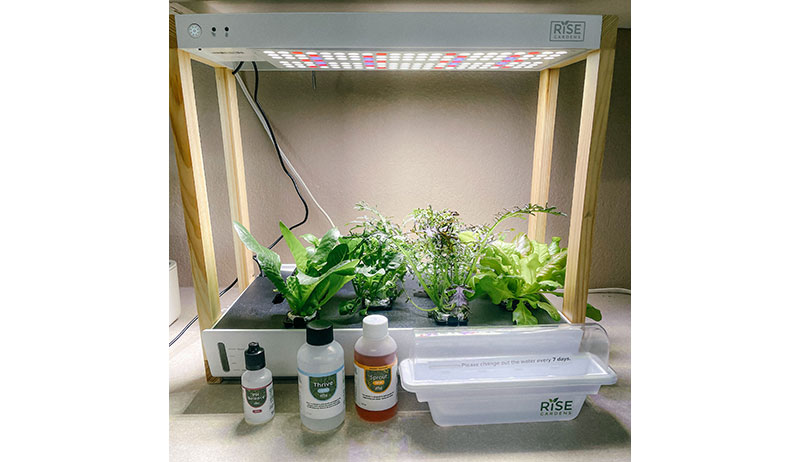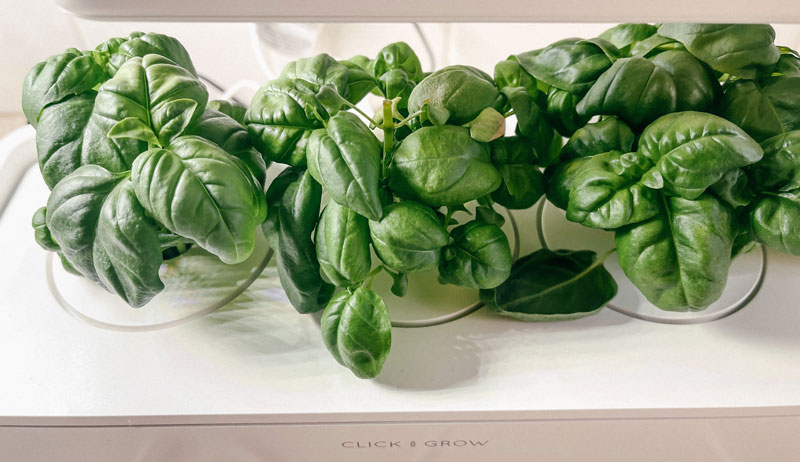
Winter is the perfect time to turn your gardening focus indoors. Indoor gardens go by several names, including smart gardens, indoor gardens, hydroponic gardens, countertop gardens … you get the idea. Whatever you call them, though, benefits of these gardens are many and include
- year-round food production
- no concern for weeds and pests
- no need for land outside to grow
For this article, we compared Aerogarden Harvest, Click and Grow 3, and Rise Personal Garden. All three of these models grow flowers, vegetables, leafy greens and herbs. All gardens use hydroponic systems, LED lights and nutrients and promise to easily grow year-round.
Looking at their costs, productivity and ease of use will provide an idea of what fits your budget and projected level of required involvement.
Read more: Get the jump on spring with these indoor growing tips!
Cost
The chart below outlines how much you will spend to get a starter kit, as well as how much you will spend in the future to keep it going. It also includes accessories available to diversify what you grow.
Each of these three companies offers multiple gardens with varying seed pods. However these are considered their most basic starter garden models.
Aerogarden and Click and Grow are more similar in price. Rise is almost double, leaving us to wonder if the added benefits are worth the larger price tag.

All gardens can be used to start seeds and come with instructions on how to transfer young plants outdoors. Rise Personal Garden and Aerogarden Harvest offer the diversity to grow microgreens.
Productivity
Which of these three smart gardens will grow the most? Obviously, the gardens that offer more pods will produce more food.
As for which ones grow the most bountiful plants, there is no clear winner. Four weeks into the growing journey, they all appeared to be at the same size of development, despite being different plants. I used basil as the control plant, growing it in all three gardens.
They all appear to be similar in size. Less does not seem to be more in this case, so if quantity is important to you, choose a garden with more pods. Aerogarden and Rise both grow more plants at once.
Read more: Interested in microgreens? We have advice for getting started.
Ease of Use
All gardens claim to “take the guesswork out of growing” and take “zero effort”. While I believe all the gardens actually do eliminate the guesswork, a little effort is needed.
Rise Gardens

Due to the Rise Gardens app for phones, they are the clear winner for ease of use. Notifications pop up on your phone announcing, “It’s time for care and adding nutrients to your garden! Click here to proceed.”
The app walks you through each step you must take to add the provided nutrients. The app also tracks how often you deep clean the garden, so you know how to keep it healthy.
The garden in the app allows you to name each pod after the plant you plan to grow in that section. When you click on the plant, it tells you what stage your plant is in (Germination, Initial growth, Mid-growth, Harvest, Past Harvest) and what to do to support or harvest your plant at each stage.
The Rise Gardens app truly is amazing. You can also adjust the lights and shop from the main site.
Click and Grow 3

Click and Grow 3 is also very simple to use due to it app. Once you input what you are growing in your garden, the app tracks the days and age of the plant.
Listed with the plant information are:
- tips on how to harvest
- fun facts
- germination speed
- sprout and harvest estimated times
You will need to use your judgment on harvesting if leaves start getting too close to the lights or if the water indicator looks low. There are no nutrients to add to this garden because Click and Grow adds all necessary nutrients in their seed pods.
This app also connects you to the store on their site to place orders directly from your app.
Aerogarden Harvest

Aerogarden Harvest does not have an app. However, they have lights on the front of the garden that light up when it is time to add water and nutrients.
The lights are on a two-week cycle to keep you checking water level and adding nutrients every other week. The lights will stay red until you click on the button to reset the time period. No app reminds you which plant is where and how many days to sprout, however their seed pods have the information printed on the top. You will need to note what’s where when you start the garden.
Some people prefer not to keep up with another app on their phone, so you’ll need to decide if that type of technology factors into your decision. Consequently, to learn more about the plants you are growing, you will have to search online.
The overall expense and ease of use for smart gardens are far less than greenhouses. The comfort of tending to your garden indoors and not having to plan around the weather are two major benefits to indoor gardening.
To decide which of these three smart gardens is best for you, decide whether cost, productivity or ease of use is more important to you.




